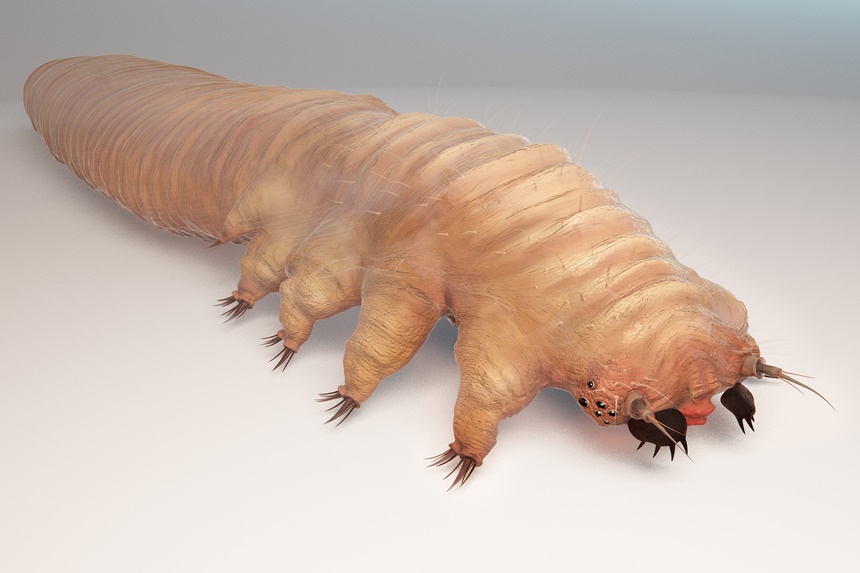Years ago, the worst thing that could happen to you from kissing a lot was chapped lips, or perhaps a case of mononucleosis. Just recently, however, scientists have found that sucking face has a whole new meaning when applied to microscopic skin mites.
It was news to me that our faces are like high-rise condos for Demodex folliculorum, a species of skin mite that resides in our hair follicles and sucks out the yummy, gummy skin flakes that accumulate within. In that sense I guess they’re like remoras for people, unseen hitchhikers that live on the dead cells they clean off us.
If that is not unsettling enough for you, picture these tiny critters slipping out of your greasy facial pores at night and crawling across your sleeping mug to fornicate.
Unlike all other mite species, the male D. folliculorum has a penis in the middle of his back. It’s toward the front, like a wee dorsal fin. The menacing score from the film Jaws would set the stage perfectly as a male skin mite emerges under a female in slow-motion (which happens to be their top speed) and does the mite-baby dance right under your nose. Literally, in this case.
Outside of the unfortunate detail that you’re now aware of these facts, D. folliculorum generally do not cause us any harm. Although in some instances, people with immune imbalances can develop an allergy to skin mites, scientists think they actually help us by keeping pores open.
But here’s the part I find even creepier than dorsal penises and nocturnal mite-sex on my face: There’s good evidence to suggest D. folliculorum will eventually become part of our faces. In a study published in June 2022 in the journal Molecular Biology and Evolution, authors G. Smith and A. Manzano-Marín et al tell the world that skin mites are in the process of merging their DNA with ours. That’s right – they are on track to become one with us. Compared to that, Yoda’s Jedi skills and Spock’s Vulcan mind-meld are mere parlor tricks.
If there was only one thing in the world you could eat, and you found a place that served it for free, it’s logical that you might want to move in as long as no one complained. Dead, sloughed-off skin cells from humans are the sole item listed on D. folliculorum’s menu. For them, dog skin won’t do, and cat dander isn’t dandy, either. But while relocating to an all-night eatery makes sense, becoming part of the establishment itself is just plain weird.
One aspect of skin mites that makes this sort of merger possible is that they have a bare-bones genome, if no actual bones. After a bazillion generations on people’s faces (and to a lesser extent, human chests), free of any predators or competitors, and with food right outside their door, the cushy lifestyle of D. folliculorum has allowed it to strip away unneeded genetic material. For example, they come out only at night, because somewhere along the line they lost the genes that code for UV-protectant pigments. These guys are in the same boat as vampires in terms of sunlight exposure.
Skin mites also went right to the bottom where mobility is concerned. Their eight legs, which are all clustered near the head, are operated by single-cell muscles. This makes me feel a lot better about my own scrawny legs, whose muscles surely contain at least two cells apiece. D. folliculorum muscles also have fewer kinds of proteins than those of other mite species.
Here is perhaps the strongest evidence pointing to a human-mite chimera in the far-off future: An organism like this has what’s called an incomplete life cycle. It matures in discrete stages, molting or shedding its skin as it moves on to the next phase. Normally, there are more cells in each successive stage. However, our face-dwelling friends do it backwards.
Not like Benjamin Button exactly, as the intermediate (nymph) phase is bigger than the larval stage. But adults have considerably fewer cells than nymphs. To me, this is just another of their quirks. But for biologists, it signals that D. folliculorum has taken the first evolutionary step toward becoming internal human symbionts, the way that mitochondria did in our distant past. The main difference would be that we’d all die without mitochondria, whereas we’d only have a bit more acne without D. folliculorum.
Don’t fret, though. Researchers point to our long association with skin mites as evidence that they play a small but beneficial role in our lives. Years ago, we didn’t know how vital a robust and diverse gut flora was to our mental and physical health. Perhaps there are other benefits of skin mites yet to be discovered. There mite be.
The author, a former Cornell Extension educator, washes his face more after this revelation.
Become a Saturday Evening Post member and enjoy unlimited access. Subscribe now




Comments
Another interesting, if disgusting, fact about these critters is that they have no anus. Consequently, they just keep eating until they succumb as a literal “poop bomb”.
Every time we bath we strip away our skins flora along with these little beauties. In many countries around the world bathing in such a manner occurs much less frequent than the “West”which perhaps is why they are typically healthier and not morbidly obese. I am interested to do more research regarding the benefits of NOT bathing so much and I will be certain to use copious amounts of antiperspirant and/or cologne
Fascinating column this week. D. folliculorum is pretty wild stuff, and has its role in the ecological hierarchy of things. Paragraphs 2 to 4 I can’t unread (ewww Paul), but life is about learning new things every day. Being jarred out of our comfort zones sometimes is a necessary part of that.
Still, daily showering with non-skin drying face and body washing is a really good thing. So on the right track, but not going to wash the sheets and pillow cases more than once a week along with the rest of the wash. Like you said, years ago we didn’t know about the importance of how a robust and diverse vital gut flora was to our mental and physical health. I’m sure more discoveries for natural healing are on the way.